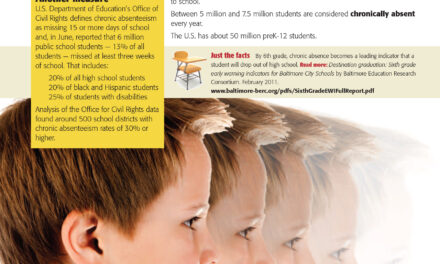 The synergy that occurs between creativity and critical thinking allows powerful learning to occur.
The synergy that occurs between creativity and critical thinking allows powerful learning to occur.
As the classroom lights dim, 5th graders jockey for better viewing positions. The facilitator introduces a projected image of Rembrandt’s “Sketch at Jack’s House” by saying, “Take a minute and look at this picture.” After students have silently studied the black and white image for about a minute, the facilitator asks, “So what’s going on in this picture?” Most arms are raised at this point. “Cassie?”
“They all look the same to me so I think they’re the same person, but like different ages, and everything like the middle one it looks like the youngest and like the one in the corner up on top — yeah, the other one — it would be old,” Cassie says.
Pointing to the figure in the corner of the image, the facilitator replies, “So Cassie’s looking at this and thinking that maybe it’s just really one person but at different stages of their life. Something about this face makes Cassie think of a younger person. What more can we find? Jeff?”
“I disagree with Cassie because you can see that that person in the middle, you can see that he or she has like curly hair, and I think it’s like a statue because of all the lines and the noncolor, and then the person up in the corner . . . he kind of has glasses,” Jeff says.
“OK, so Jeff is noticing some differences in these people, wondering if this person up here doesn’t have glasses and noticing the curly hair around this person and agreeing that this is probably some kind of a sketch. What more can we find? Kylie?”
“I kind of agree with Jeff that it’s like someone sketched it because of all the lines and how like some areas are shaded,” says Kylie.
“So what do you see that makes you say shaded?”
“Because it seems like darker than all the others, like darker than all the other spots,” says Kylie.
“So noticing the darker and thinking that perhaps someone has shaded that. What more can we find?”
“I agree with Jeff, or whoever said it was a drawing and I notice that like in the top — my right upper side — that person could be a girl because it looks like that face, on the top, yeah, that guy looks like he could be in his 80s or something because he looks kind of older,” Kacey says.
“What do you see that makes you say older?”
“Because he has like glasses. And he has kind of like his chin, he has a beard,” Kacey replies.
“OK, so noticing some features about this person’s face and thinking yes, I agree that that one seems to be older and perhaps that one could be a female face. What more can we find? Connor?”
“I think it’s some sketches that Leonardo DaVinci made,” Connor says.
“So Connor’s agreeing here that we’ve got some sketches. What more can we find? Ashley?”
“I disagree with Connor because it says down there like the artist signed it, Rembrandt 1636. It could be 10 or 16 because just the way it looks, the writing’s kind of faded. I don’t know. I’ve heard of Rembrandt before,” Ashley says.
“I agree that it’s Rembrandt, and I think the year is 1636 just because of like very few people say 1036 because . . . if you look at the little circle because if you compare the two sixes . . . the little top part goes higher than the number to make it a six,” Allison says.
This Visual Thinking Strategy session at Camelot Intermediate School in Brookings, S.D., illustrates the creative and critical thinking skills used when 4th and 5th graders discuss art.
Making meaning together by observing carefully, deciphering patterns, speculating, clarifying, supporting opinions, and generating more ideas — these skills are learned patterns of thinking. Camelot teachers nurture these student behaviors by facilitating monthly art discussions. The staff originally chose Visual Thinking Strategies (VTS) to improve student writing. Now they recognize that, in addition to strengthening students’ communication skills, VTS generates critical-thinking skills, including creativity.
Visual Thinking Strategies strengthen students’ communication and critical-thinking skills, including creativity.
The intersection of creativity and critical thinking lies at the heart of VTS. Creativity involves exploring patterns, shapes, textures, and colors through visual means. Critical thinking involves examining clues, considering alternatives while holding opposing ideas and exploring possibilities. These two processes are closely related. When they come together through VTS, the synergy produces a sweet spot for powerful learning to occur.
Camelot teachers describe a VTS session as providing time and space where students learn to create meaning from art. VTS uses three deceptively simple questions that invite students to freely share their multiple perspectives about art images:
- What’s going on in this picture?
- What do you see that makes you say that?
- What more can you find?
The first question prods viewers to consider the art in an open-ended way. The second question challenges students to support their views using evidence in the image. For example, in the opening dialogue, Cassie and Jeff gave reasons for their speculations about the characters’ ages. The third question implies that there is more in the image to be uncovered, contemplated, and discussed (Housen & Yenawine, 2009). Throughout the cyclical process, the teacher’s nonjudgmental facilitation style accepts all student responses and thus develops a safe, collaborative environment. In the dialogue, Ashley and Jeff felt comfortable in politely disagreeing with their peers. During an academic year, teachers facilitate nine monthly discussions of three images each, concluding with a museum visit as the tenth discussion. Each discussion lasts about 45 minutes.
During three years of implementing VTS curriculum, Camelot staff has reflected on its effect on student behavior, thinking, and writing. Teachers identify key elements of critical thinking and creativity in the way students respond during VTS sessions. Principal Dave Fiedler also said these skills transfer to other areas of the curriculum and even school life. “I would say without any doubt that the Visual Thinking Strategies has been a positively worthwhile endeavor for our students and our teachers. The VTS process has helped them [teachers] become better facilitators and allow students a little more control of the learning environment,” he said.
South Dakota State University researchers and South Dakota Art Museum staff have tracked this development and supported its growth from the beginning through regular staff debriefings and individual coaching sessions. This collaboration, as a community of practice, started a journey to explore creativity and critical thinking through the use of art.
Creativity & critical thinking
Thinking creatively includes brainstorming, creating new and worthwhile ideas, elaborating, refining, analyzing, and evaluating. In addition, creativity includes working with others in:
- Developing, implementing, and communicating new ideas;
- Being open to new perspectives;
- Incorporating group input into the work;
- Demonstrating originality and inventiveness;
- Understanding the real-world limits to adopting new ideas; and
- Viewing failure as an opportunity to learn within a long-term cycle of small successes and frequent mistakes (Partnership for 21st-century skills, 2011).
VTS teaches students to do all of these in a collaborative process. French artist Marcel Duchamp said, “All in all, the creative act is not performed by the artist alone; the spectator brings the work in contact with the external world by deciphering . . . its inner qualification and thus adds his contribution to the creative act” (Lebel, 1959, p. 77-78). The Camelot staff reflections, referenced below, demonstrate the creative process at work within VTS discussions.
Creativity
Creativity: developing, implementing and communicating new ideas. Camelot teachers noticed that VTS encourages storytelling as students attach actions or experiences to the characters in the images, thus animating the art. Sometimes students’ storytelling explored the image on a deeper level by considering character, plot, and setting. “The first reply I received was from a student who is usually in her own little world and not paying attention. She said, ‘This is set in the summertime because there is grass, and the people aren’t wearing coats.’ I was impressed because she was focusing on the setting, which I had introduced several weeks ago.”
Creativity: being open and responsive to new perspectives. In a VTS discussion, the facilitator accepts each student’s observation in a neutral manner, modeling receptivity to new ideas that the students soon imitate. They develop an “openness to each other’s ideas.” “When asked what the best thing was about VTS, my students agreed that it was that all students could share an opinion, and nobody’s opinion was wrong.” The facilitator’s summary and paraphrasing set the tone for civility.
Creativity involves exploring patterns, shapes, textures, and colors through visual means. Critical thinking involves examining clues, considering alternatives while holding opposing ideas and exploring possibilities.
Because teachers paraphrase each discussion, students feel appreciated. Their thoughts are important and heard. Teachers incorporate conditional language, such as “looks like,” “might be,” or “so maybe” in the paraphrase, which also helps students learn to value multiple perspectives.
Creativity: incorporating group input into the work. Teachers observe students “putting their minds together . . . building on each other’s observations, ideas, and knowledge.” “As soon as someone mentioned the sick woman, other students looked for more evidence to show that there was sickness in the house. Someone noticed the medicine and the steamer.” Student observations often evolve into respectful debates.
As they considered each other’s opinions of the same image, students demonstrated flexible thinking, another hallmark of creativity. “One student originally felt this picture was set in modern times but changed his opinion when another student pointed out the old-fashioned radio. This comment started a small debate when still another student said his relatives collect antiques and live in an older home, and therefore it could be in the present and not the past. Several thought it could go either way. This discussion assured me that my students are listening to each other during VTS.”
Creativity: demonstrating originality and inventiveness in work. Being creative requires “generating as many ideas as possible” (Mackay, 2012), a process that occurs naturally in VTS. “I finally had one student notice that it was a fur hanging over the man’s arm, and this observation was such a revelation to the class. It was met with lots of oohs and ahhhs!” Since art images lend themselves to interpretation, students feel free to explore. “A few were seeing a story, but more were very fascinated in the structure. This aspect led to some interesting suggestions on how the art was made and its purpose.” In the opening dialogue, Kylie noticed the details of shading in the sketches, and Allison compared the two 6’s, to add depth to the observations. After two years of VTS, teachers commented that they and their students were looking at art differently — beyond the first glance.
Creativity: understanding the real-world limits to adopting new ideas. Teachers occasionally encounter students who test the real-world limits of ideas. “Every once in a while, students propose ideas that don’t seem to be likely. If this does happen, I simply ask them to tell me what they see in the picture that makes them say that. Usually they respond with ‘never mind.’ Then we move on. This strategy doesn’t seem to keep that person from sharing again. Sometimes, he even shares another idea or two about the same image.” One teacher said, “[In lesson one,] there was one ‘off the wall’ answer that was given partly to see my reaction. When I didn’t react, but asked the student what he saw to say that, he paused for a time and then came up with a reasonable answer.”
Creativity: a long-term cycle of small successes and frequent mistakes. Cyclical thinking happens when students return to an idea to discuss it more. Teachers also noted improvement in students who may struggle speaking with the group. “I have been very surprised by one particular student. His learning and social disabilities keep him from participating in most general education classes. This student loves VTS. He says he agrees with others and has really improved. He does not like others to disagree with him, but at least he acknowledges varied opinions.” Another teacher shared ways to encourage the small successes. “Sometimes my students with disabilities will simply repeat an idea that has already been suggested. Therefore, I often try to get them to share first so that they are informally credited with coming up with an idea that most of the class agrees with.”
Critical thinking
Through VTS students also engage in critical thinking, defined as:
- Reasoning effectively both inductively and deductively;
- Using systems thinking to analyze the interactions of parts in a whole;
- Making decisions that include examining evidence, analyzing it from different perspectives, synthesizing and making connections between information, drawing conclusions, and reflecting critically on experiences; and
- Problem solving by looking at issues in both familiar and innovative ways, and developing significant questions to find better solutions (Partnership for 21st-century skills, 2011).
Reasoning using inductive and deductive means. Camelot teachers most frequently noted their students using critical thinking and reasoning by making connections to previously learned materials and personal experiences. Students related observations to Martin Luther King, Jr., indentured servants, and Chinese-style slippers.
Using systems thinking to analyze the interactions of parts in a whole. Students analyzed the pieces of an image and used their ideas to interpret. One student noticed a gray sky and determined a storm was coming. After studying the painting further, he changed his mind, deciding that the dark sky came from a smoking factory chimney. He dissected the image, explored possible causes and effects, and generated reasons for the gray sky.
Making decisions and judgments through evidence and alternative perspectives. The student above evaluated the evidence and reached a different conclusion. Students familiar with VTS also began holding different perspectives simultaneously. “Several students provided multiple theories for a single picture. I did not ever feel as though any of the students were looking for just one right answer. They seemed to embrace that there could be various scenarios to describe the picture.”
Making judgments by synthesizing and making connections. Some students connected to prior knowledge, while others found connections to self, then to others, and finally to content. Students who had struggled to contribute started making self-connections. One said, “It looks like a rotary lawnmower; my grandpa has one.” Others connected to culture, for example, inferring that the family “must be Christian because of the cross and holy picture on the dresser.” When an African landscape appeared in an image, a recent immigrant described her hometown and the cultural aspects in the picture, making both self and cultural connections.
Often, ambiguous objects in images sparked the most inferences as students attempt to comprehend the image. Teachers were “continually surprised at how much they can get from these images.” Ambiguity encouraged students to dig deeper into what they know.
Teachers were continually surprised at how much students got from analyzing these images.
Making decisions and drawing conclusions. VTS encourages students to re-evaluate their thinking after hearing others. Students don’t dismiss an idea, but rather carefully consider and weigh options before drawing conclusions. Teachers found VTS skills transferring to other areas of school life, such as when the Camelot Knights of the Round Table, which serves as the student council, listened to a community member pitching a service idea. The presenter expected to hear, “Yes, let’s do this!” Instead, he heard the Knights agreeing and disagreeing politely as they debated the proposal. The group’s advisers found themselves explaining VTS to the surprised guest.
Making decisions by pausing to think to build on reflective processes. Teachers reported VTS also affects the writing process because students spend time thinking about their ideas first. “[During the postwriting activity, students] are adding more details. I see more thinking going on before they write something too. They don’t just start in writing. Most will use a little think time.”
Problem solving. Students solve problems by developing a mind-set that uses critical thinking in many different settings (Housen, 2001; Karakas, 2010). In the opening dialogue, Allison analyzes the numbers in the date by examining their shape. Since VTS provides these ongoing opportunities in a cyclical, predictable fashion, it has become a set of tools for helping students become citizens of their learning communities outside of VTS sessions. Teachers incorporated VTS-style discussions into their project-based learning units by posing the question, “Which books are high quality?” Then students developed criteria for a Camelot Literary Award, selected books, presented their nominations, and voted to bestow their awards to the winning books. Students studied the Caldecott Medal image as a model before creating their own; within this authentic, democratic process, all students participated.
If we want students to unlock their creativity, to take intellectual risks, and to think outside the box, teachers must create a space where that can happen. In VTS, teachers shape new ways of teaching, while their students shape new ways of thinking.
References
Housen, A. (2001). Aesthetic thought, critical thinking and transfer. Arts and Learning Research Journal, 18 (1), 99-132.
Housen, A. & Yenawine, P. (2009). Basic VTS at a glance. www.vtshome.org/research/articles-other-readings
Karakas, S. (2010, September). Creating and critical thinking in the arts and sciences: Some examples of congruence. Forum on Public Policy, 2010 (2), 1-9.
Lebel, R. (1959). Marcel Duchamp. New York, NY: Grove Press.
Mackay, H. (2012, July 16). Outswimming the sharks. Minneapolis Star-Tribune. www.startribune.com/business/162415446.html
Partnership for 21st-century skills. (2011). 21st-century framework-creativity. www.p21.org/overview/skills-framework/262
CITATION: Moeller, M., Cutler, K., Fiedler, D., & Weier, L. (2013). Visual thinking = creative and critical thinking. Phi Delta Kappan, 95 (3), 56-60.
ABOUT THE AUTHORS

Dave Fiedler
DAVE FIEDLER is principal of Camelot Intermediate School, Brookings, S.D.

Kay Cutler
KAY CUTLER is a professor of early childhood education and director of the Fishback Center at South Dakota State University, Brookings, S.D.

Lisa Weier
LISA WEIER is a 5th-grade science and language arts teacher at Camelot Intermediate School, Brookings, S.D.

Mary Moeller
MARY MOELLER is an associate professor of teaching, learning, and leadership at South Dakota State University, Brookings, S.D.










